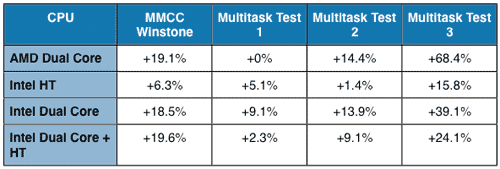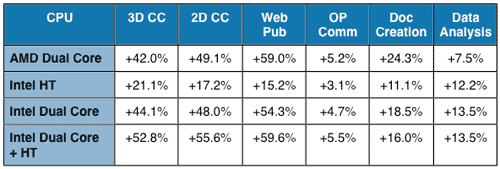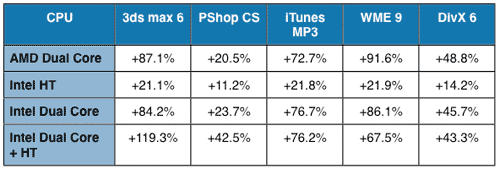Affordable Dual Core from AMD: Athlon 64 X2 3800+
by Anand Lal Shimpi on August 1, 2005 9:36 AM EST- Posted in
- CPUs
AMD's Efficiency Advantage?
Before we get to the actual barrage of performance tests, there is one issue that we have been wanting to tackle for quite some time now.AMD has often argued that their dual core architecture is inherently more efficient than Intel's, primarily because of their System Request Queue (SRQ). All core-to-core transfers occur via this queue instead of over a main, shared FSB, which is the case in the Pentium D.
Johan put AMD's architecture to the test by measuring the latency of cache-to-cache transfers in AMD's dual core chips vs. Intel's. The results were quite impressively in favor of AMD's architecture. Cache-to-cache transfers on Intel's dual core CPUs took over twice as long as on AMD's dual core CPUs, but at that time, we could not find any real world benefit to the architecture.
Armed with a bit more time, we went through all of our benchmarks and specifically focused on those that received the most performance gain from dual core architectures. Using these multithreaded and/or multitasking benchmarks, we looked at the performance improvements that the dual core processors offered over their single core counterparts. For AMD, making this comparison was easy; we took the Athlon 64 X2 3800+ and compared it to its single core equivalent, the Athlon 64 3200+. For Intel, the comparison is a bit more complicated. The inclusion of Hyper Threading makes the single-core to dual-core jump a little less impressive in some cases, thanks to the fact that virtually all single-core Pentium 4 processors these days can execute two threads simultaneously. Thus, for Intel, we had to look at HT enabled, dual core and dual core with HT enabled, all compared to single core performance to get a complete picture of Intel's multithreaded performance scaling.
Remember that all performance increases are with reference to a single core processor, and in the case of Intel, we are talking about a single core Pentium 4 with HT disabled. More specifically, we used a Pentium D 830 (3.0GHz) for the dual core tests and compared it to its single core counterpart - the Pentium 4 530 (3.0GHz).
First, we have our Winstone 2004 benchmark suite; we omitted Business Winstone 2004, since it shows virtually no performance boost from dual core CPUs and instead, focused on Multimedia Content Creation Winstone 2004 and the Multitasking Winstone tests.

It is also worth noting that although Hyper Threading improves performance with a single core, enabling HT on the dual core CPU actually yields lower overall performance than if we had left it off (+24.1% vs. +39.1%). Johan explained exactly why situations like this exist on the Pentium D in his "Quest for More Processing Power".
Next up is the SYSMark 2004 suite. In all but two of the tests, AMD scales slightly better than Intel when going to dual core. The scaling advantages aren't huge, but they are tangible in some of the tests.

Once again, while Hyper Threading itself tends to impress, HT + dual core gives us a mixed bag of results, sometimes outperforming dual core alone while falling behind other times.
Finally, we have our application-specific benchmarks; here, we have AMD scaling better than Intel in 3 out of the 5 tests, but then in the remaining 2, Intel scales better.

While the Athlon 64 X2 does have much better cache-to-cache transfer latencies than the Pentium D, it appears as if for the most part, those advantages don't surface in real-world desktop usage. That being the case, the Athlon 64 X2 3800+ must outperform the Pentium D 830 based on the performance advantages of its individual cores in order to win this battle, not based on any dual core architectural efficiencies. So, does it?










109 Comments
View All Comments
Houdani - Monday, August 1, 2005 - link
By that same logic, should Intel cut prices on the Pentium D 830, 840, and EE down to the same price as the Pentium D 820? Of course not, because with higher performance comes higher prices.Sure, AMD could release a 1.8GHz X2 3400+ at a $250 price point to cross with the Pentium D 820, but before that happens they'll continue to make a profit with what they've got before introducing a new chip which has been artificially gimped in order to meet the needs of the low end/entry market.
still - Monday, August 1, 2005 - link
Except that by the time you get a new motherboard that supports that cheaper Intel chip and the pricier DDR2 memory, any price advantage Intel had is already gone. And the AMD system still outperforms the Intel one 15% in for the 830D and 20% in the 820D. So choose wisely...SDA - Monday, August 1, 2005 - link
You know what's funny? Most of the customers I've had were more than happy to pay extra to have a PC that ran very quiet and cool. All of them said they'd like that, actually, but most of them added that they wouldn't mind a hefty premium. So do you think these customers would bite if I told them that $100 would buy them a faster, more capable, and cooler-running processor?Oh, it's expensive, to be sure. But saying that no one will ever want it just because you don't is, well, stupid.
fishbits - Monday, August 1, 2005 - link
"one major flaw in AMD's execution: price""AMD's Athlon 64 X2 was the better overall performer, just at the very wrong price point."
Anand, I wish you and the rest would seriously sit down and think about all the sniping and whining you've done lately about the prices of high(er)-end products. How, exactly, was AMD's price execution flawed? They can only make so many of the X2 chips, and they have been flying off the shelves at and above their suggested price. It's not like AMD's "flaw" was pricing them so high no one was buying them and they were gathering cobwebs in warehouses. What's "wrong" about this price point?
Let's look at it this way, is AnandTech "flawed" and "wrong" in its advertising pricing? I mean you could sell front-page add space for $5 per month. Or do you charge a reasonable price that keeps ads to a reasonable (non-overwhelming) number of ads on a page, without pricing so high that there's huge droughts of no ad revenue?
I couldn't care less if you were to deem products "too high to recommend to most users for their budgets and needs" and the such. But it's pretty petty that you and the crew constantly take slaps at products and their manufacturers because they're priced higher than we'd WISH they'd be, but still selling quite well and making those who can afford them quite happy. A new Corvette costs more than a Neon. This isn't "flawed" or "wrong." It's just another factor to take into consideration when purchasing and recommending. Now if something is seriously overpriced for its ability, by all means point it out. But stop coming across like you have no clue that the prices for higher-end parts ramp up quite steeply, and deservedly and understandably so. Been this way for decades and will continue to be this way for decades to come.
masher - Monday, August 1, 2005 - link
From AMD's perspective, there may be nothing "wrong" with pricing X2 chips far higher than two equivalent single CPUS...but from the consumer's persective, such a price point is most certainly flawed.So are you a consumer or an AMD stockholder? It should be obvious that-- for the average consumer-- a second core priced far above the first is a poor purchasing decision, and that such pricing will never lead to significant market penetration.
fishbits - Monday, August 1, 2005 - link
But that's just it, AnandTech is taking the stance that it is wrong from AMD's perspective, not from the consumer's. That is where I think they've gone off track. As far as a second core being priced far above the first, color me unfazed. If somehow AMD or Intel were able to bump single-core clock speed by 50%, would any of us be suprised that the new chip would cost (gasp!) AT LEAST double the price? On a dollars-per-Mhz scale, of course it's a loser. On a "getting my hands on a high-end performer" scale, it's easily a winner at double the price. Look at how much more we pay for just a 20% bump in single-core clock speed, and yet it doesn't generate the kind of whining that adding a whole second core and cache does."...Such pricing will never lead to significant market penetration".
Funny, last I heard X2s were selling very well, especially when measured against AMD's ability to produce them. As always, when production ramps up the cost will go down.
The other thing I'd add is that it's my understanding that the 820, a very good performer for its price, is that it's a subsidized chip. I gather (though could be wrong) that Intel sells them for zero profit, or even loses money on them to bump up market share. If that's the case, then its pricing is somewhat an exception and that should be provided as appropriate context in any comparison as Intel has the size and cash to do this, where AMD doesn't.
masher - Monday, August 1, 2005 - link
> "But that's just it, AnandTech is taking the stance that it is wrong from AMD's perspective..."I think you're reading your own bias into his statements.
> "Funny, last I heard X2s were selling very well, especially when measured against AMD's ability to produce them..."
Actually, they are selling well ONLY when measured against AMD's ability to produce them. An ability which is nearly-nonexistent. A few thousand cpus a month may sound like a lot to you, but it doesn't even pay for lunches at the corporate HQ, much less fund a few new multibillion dollar fabs.
AMD's trickle of high-priced X@ sales was useful for bootstrapping future sales...but for gaining any significant market share-- or even paying off a portion of the X2 R&D costs-- it was a nonentity. As I said before.
dougSF30 - Monday, August 1, 2005 - link
<i>but from the consumer's persective, such a price point is most certainly flawed. </i>Not so, because the infrastructure cost for a dual-socket equivalent is significantly higher.
masher - Monday, August 1, 2005 - link
But the comparison isn't between an Athlon and a dual-socket Opteron setup...but between AMD and Intel dual-cores. The "flaw" is charging $300-400 for a second core, when Intel will give you one for $100.Let's face it...while AMD trounces Intel in gaming and other single-threaded apps, performance is neck-to-neck for highly scalable apps...just the ones you'd want a dual-core processor in the first place. AMD can't afford to charge far more than Intel for these cores...not if they want to sell more than a few thousand cpus to the fanboi brigade. They have to bring their prices more in line. A step they've taken with the launch of the X2 3800.
mlittl3 - Monday, August 1, 2005 - link
Your power comparison graphs list both the manchester and toledo cores as having 512K cache. Is this a typo?